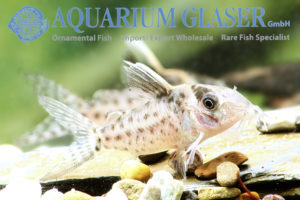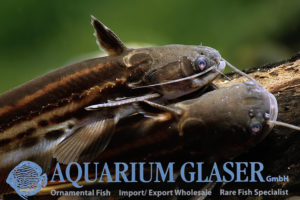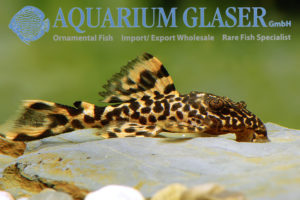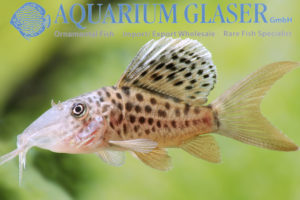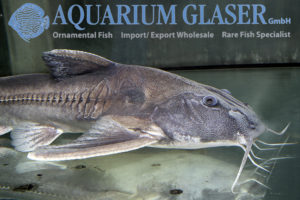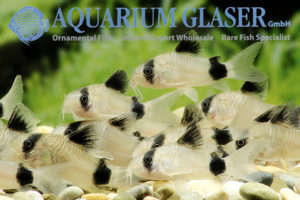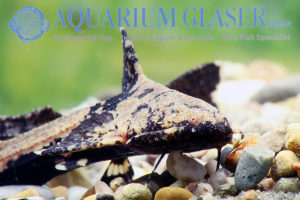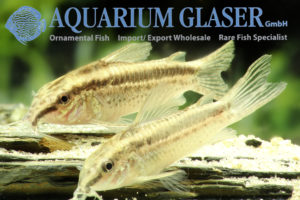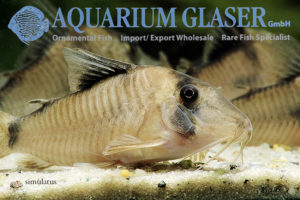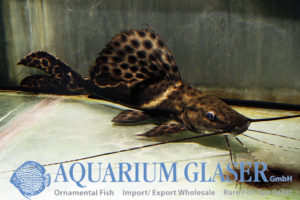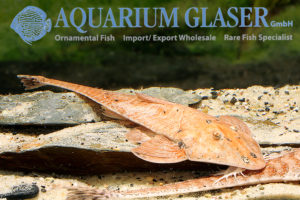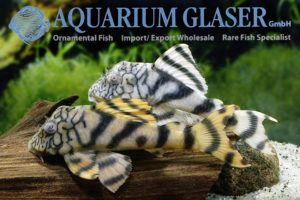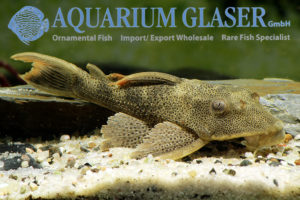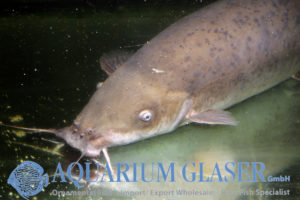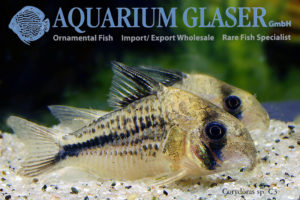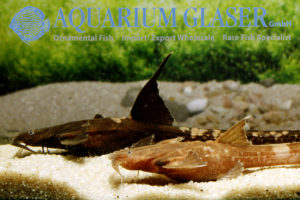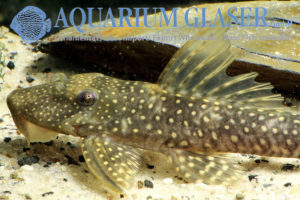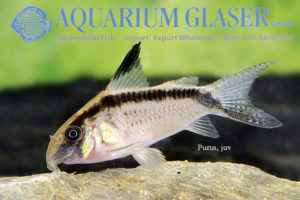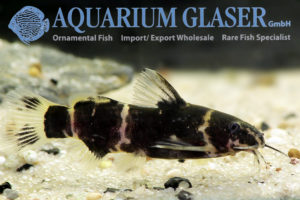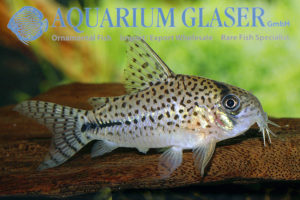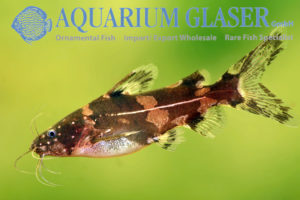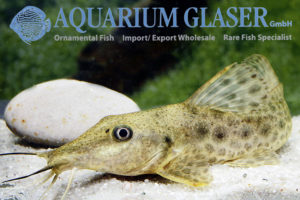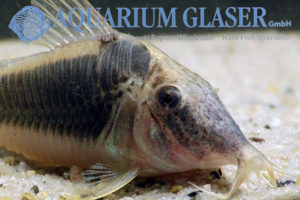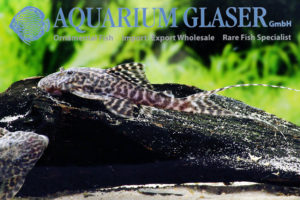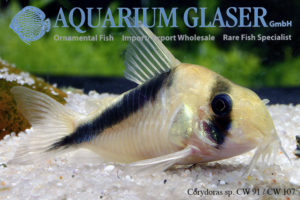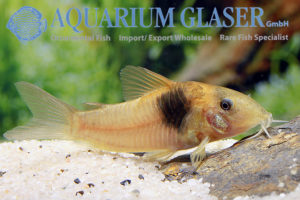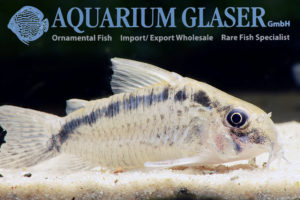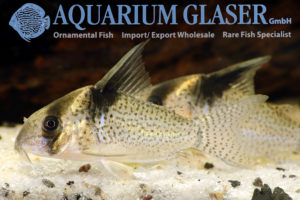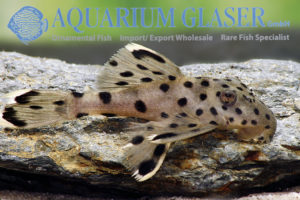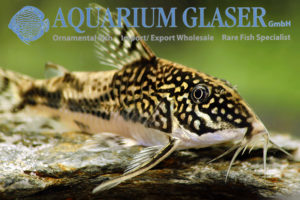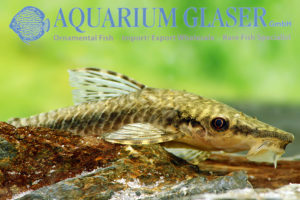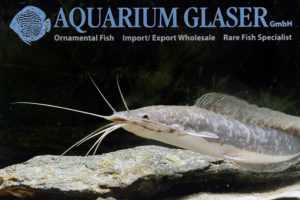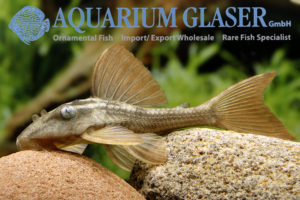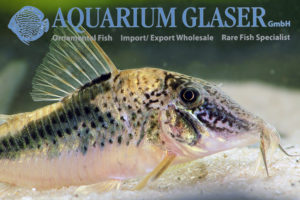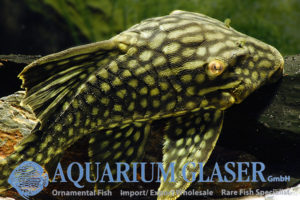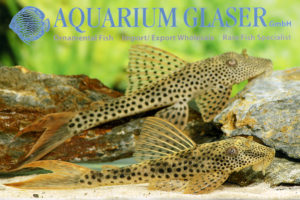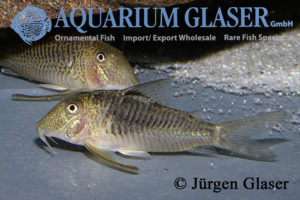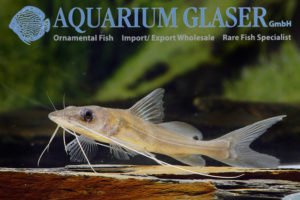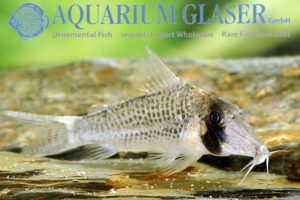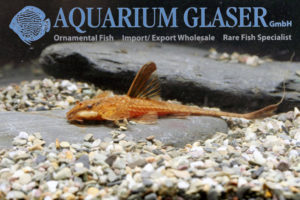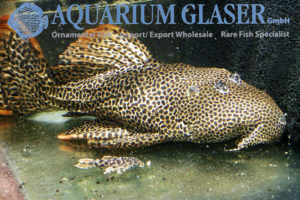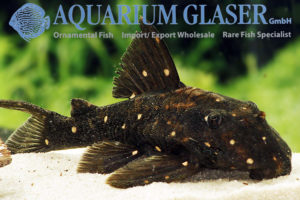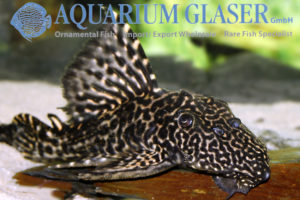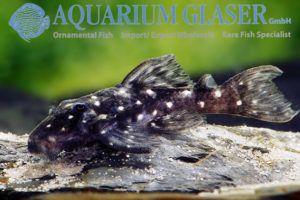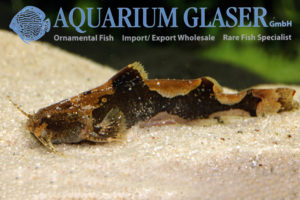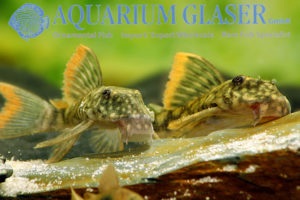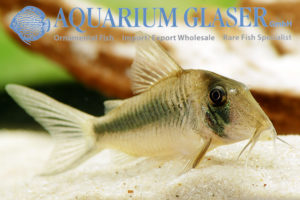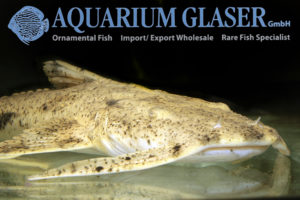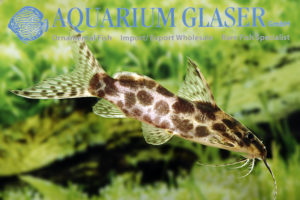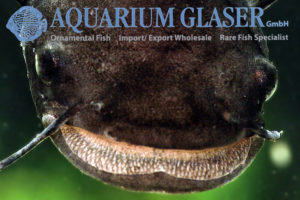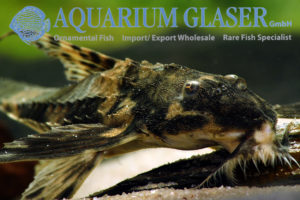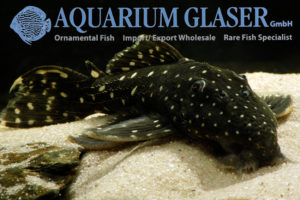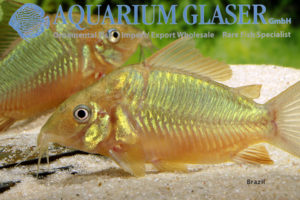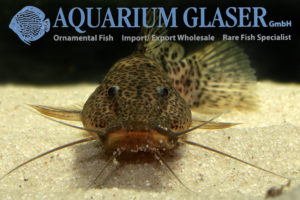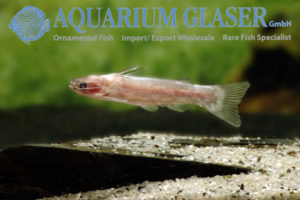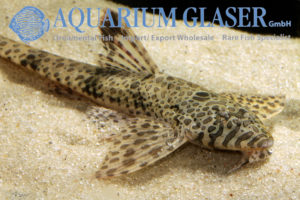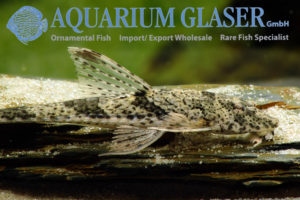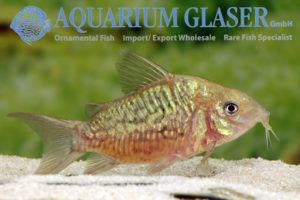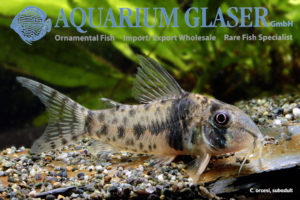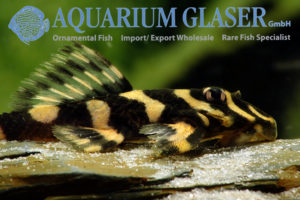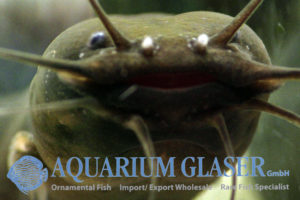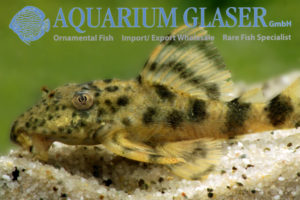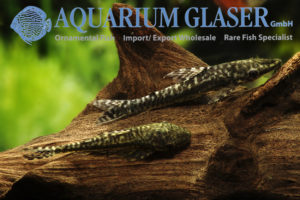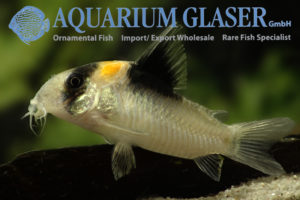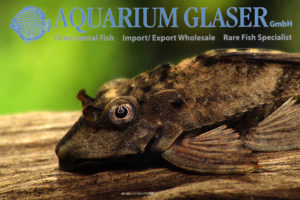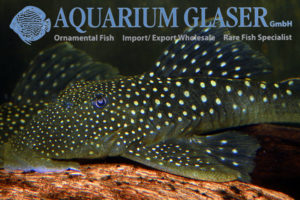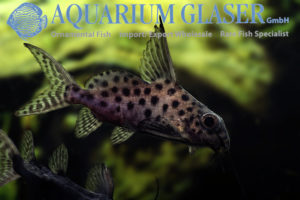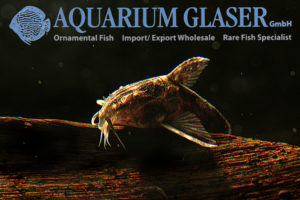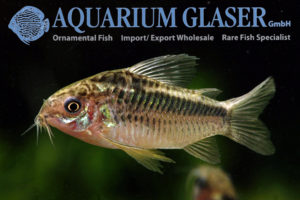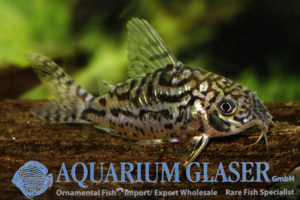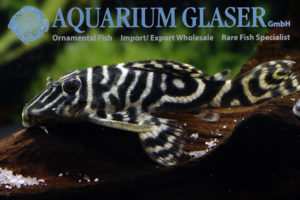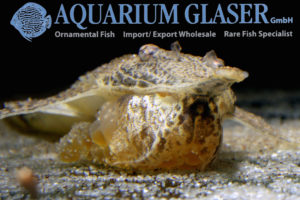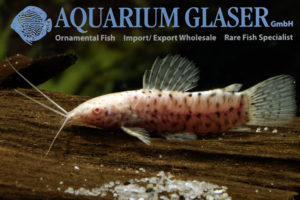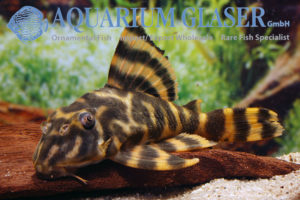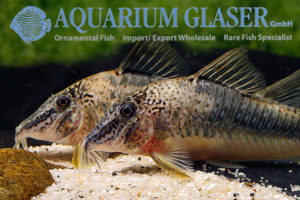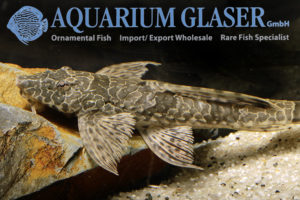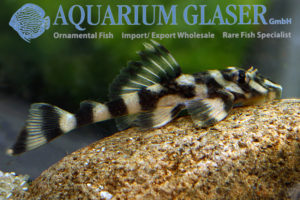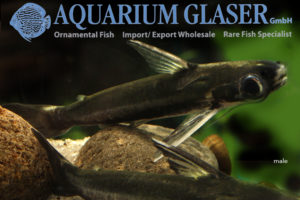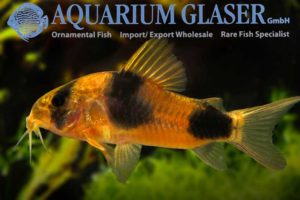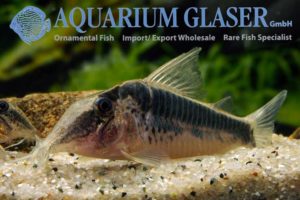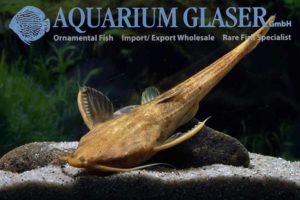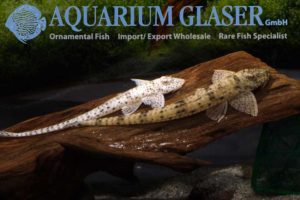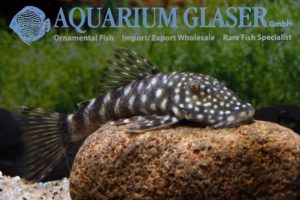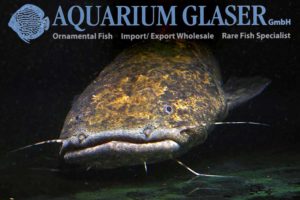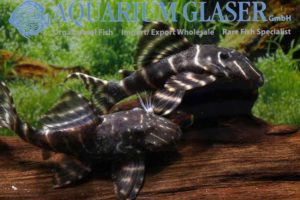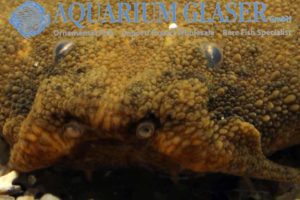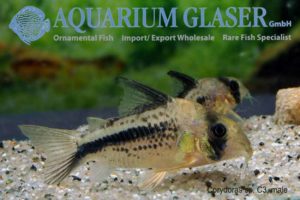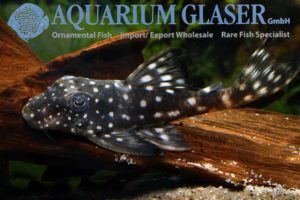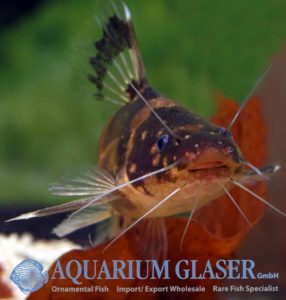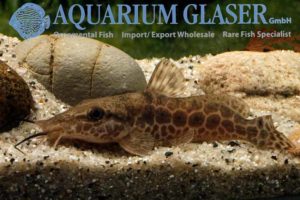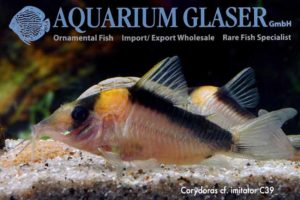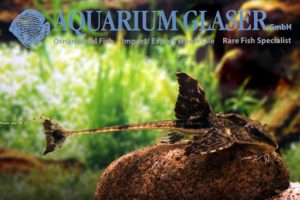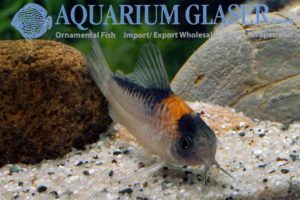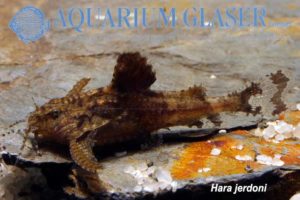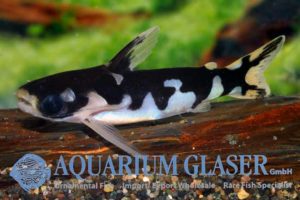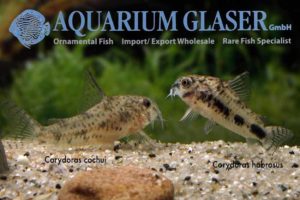The magnificent Corydoras robustus belongs to the biggest species of its genus. Up to 95 mm standard length (i.e. without caudal fin) have already been measured in females of this species. Females become somewhat bigger than the males. Both sexes develop long dorsal fin rays, what looks very nice. For more pictures of adult animals […]
10. Catfishes (748)
-
-
Trachelyopterichthys taeniatus
Among the driftwood catfishes are some quite attractive coloured species. This is a bit astonishing, for these catfishes are usually strictly night active and hide during daytimes in caves or crevices. However, well settled animals usually come out of their wholes at feeding times in the aquarium. Trachelyopterichthys taeniatus belongs to the really attractive species. […]
-
Leporacanthicus triactis VARIETIES
Currently we received an import from Venezuela, which included small, only 3-4 cm long specimens of Leporacanthicus triactis, also known as L91. Among them are an unusually large number (approx. 10) of unusually beautifully drawn variants. Normally small L91 do not look much different than the adults, only a little lighter in basic tone. But […]
-
Brochis multiradiatus BRED
The big emerald-corys of the genus Brochis clearly differ from all species of Corydoras through the long back-fin, that contains essentially more fin-rays. While Corydoras have 7-8 rays in the back-fin, Brochis have 10-18. The care of all Brochis is easy and hardly differs from that of the remaining corys, however, the breeding succeeds only […]
-
Centrodoras brachiatus
In two large specimens (they are currently 20-25 cm long) we have received the extremely rarely imported Centrodoras brachiatus from Peru. The up to 40 cm long catfish are widely distributed in the Amazon system and also occur in Brazil and Colombia. Typical is the form of the lateral bone row, whose shields are very […]
-
Corydoras panda
The panda cory from the Rio Ucayali in Peru belongs to the most popular species of the genus. This applies both to the aquarists, who have a community aquarium, and to the breeding aquarists, because Corydoras panda is quite easy to breed and productive – if you know how to do it, of course. We […]
-
Acrochordonichthys rugosus
If this catfish came from South America, then one would count it without question to the banjo catfish. But in reality, Acrochordonichthys rugosus comes from Southeast Asia, where it is widespread and science has known about it for a long time, but from where it is only rarely exported as an aquarium fish. A special […]
-
Corydoras gracilis
The habitats of Corydoras gracilis in the entry of the Rio Madeira are clearly off the beaten track of ornamental fish collectors; furthermore, the nimble little animals, which know how to hide themselves perfectly in the maze of branches that have fallen into the water, are difficult to catch one by one. That is why […]
-
Corydoras simulatus
From Colombia comes the pretty long-snouted Corydoras simulatus. There it lives in the same rivers – the Rio Meta and its tributaries – as the round-snouted Corydoras metae. Because the latter have been known for a long time already, the scientific describers of C. simulatus chose the species name “simulatus”, in the sense of “only […]
-
Hey, hey, hey, hey, little pirate…
This is the chorus of a Rodgau Monotones´ song about a small employee who breaks out of his hated everyday life and puts on an eye patch to continue living as a pirate in the future. We had to think of this song when a magnificent Leiarius pictus from Peru arrived on Wednesday. The animal […]
-
Sensational: Red Pseudohemiodon apithanos!
Recently we received red chameleon whiptails (Pseudohemiodon apithanos) from Colombia. The coloration of the eight specimens (a ninth was a “normal” apithanos, which we also received) is really fantastic. Red variants can be found in different loricariid catfish, think of Hemiloricaria and Ancistrus, but for the genus Pseudohemiodon they are not known yet. The individual […]
-
Peckoltia sp. L135
Currently is season for one of the most beautiful members of the genus Peckoltia, namely L135. The species originates from the Rio Negro and can be easily recognized by the “wormline-pattern” on the head. Only two other species of Peckoltia show a similar pattern: P. braueri from the Takutu river and P. sp. L121 from […]
-
Hypostomus rhantos L242
With almost 150 accepted species, the genus Hypostomus (in the broadest sense) is the most species-rich group of loricariid catfish. Unfortunately, there is no current revision of all species and so the determination of Hypostomus is usually a laborious affair, in the end often only a questionable result. Hypostomus rhantos is pleasingly easy to recognize. […]
-
Malapterurus microstoma 50 cm!
We usually get electric catfish from Nigeria in the form of the species Malapterurus beninensis. This is a medium sized species that grows to 20-30 cm in length. In April 2017 we received electric catfish from the Congo. From there 4 species are registered: Malapterurus monsembeensis (Syn: M. gossei), M. melanochir, M. microstoma and M. […]
-
Corydoras sp. C3
Shipments declared as “Corydoras bondi” from Colombia are always subject of surprise. The distribution of the real C. bondi is restricted to the Guyana countries. So sometimes Corydoras axelrodi, sometimes C. loxozonus, and sometimes the scientifically undescribed C. sp. C3 are shipped under that flag. This time we received the pretty C3. However, all three […]
-
Platystacus cotylephorus
We received this beautiful banjo cat from Brazil currently. The species represents by far the most desirable member of the family. The fish becomes approximately 30 cm long and thus should be kept in larger tanks. In contrast to most other banjo catfishes – which usually do not move if possible – this species is […]
-
Pseudancistrus sidereus
Nasty people could say: another brightly spotted brown-black loricariid catfish. But the heart of real fans of this group of animals beats faster at the sight of the fish, which differs from all other L-catfish by the combination of the crescent-shaped dorsal fin and the tail fin coloration, which is actually typical for Lasiancistrus species. […]
-
Corydoras arcuatus “Purus”
The skunk cory is one of the most famous Corydoras species – you might think! In reality it is most probably a scientifically undescribed species, while Corydoras arcuatus – this scientific name is used for the skunk cory – is hardly ever on the market. But regardless of that: the regularly in large numbers available […]
-
Microsynodontis batesii
Squeakers or upside-down catfishes are a fish family occurring exclusively in Africa. The best known genus is Synodontis, which comprises over 130 species. Closely related to this genus is the genus Microsynodontis. The genus name means “small Synodontis” and is program, because these fish already become sexually mature with 3-4 cm of length, are thus […]
-
Corydoras sp. C91
We received beautiful Corydoras sp. C91 from Peru (Rio Huallaga). The splendid species belongs to the closer relationship of Corydoras julii, C. punctatus, and C. trilineatus. The species was called Corydoras sp. “Heiko” or C. sp. “Peru-Bondi” in the trade before it was given a C-number. The peaceful schooling species gets the most brillant colours […]
-
Pseudomystus funebris
Again we could import a cute blackwater dwarf catfish from Indonesia, this time from Borneo. Pseudomystus funebris was only scientifically described in 2010 and is extremely similar to P. heokhuii which occurs on Sumatra. Like the latter, it reaches a total length of about 6 cm. The species is very peaceful and also constantly on […]
-
Auchenoglanis sp. Niger (A. biscutatus)
Until recently only two species of Auchenoglanis were recognized as vaild: A. biscutatus from the Nile and the whole of West Africa and A. occidentalis from Central Africa. But in 2010 the genus was revised by Retzer, who accepted a total of 8 different species, 7 already described formerly and one new species, namely A. […]
-
Corydoras Rarities
From Peru we received samples of some top rarities among the armored catfish. All belong to the group of long snouts, which in contrast to the round snouts do not live in swarms, but have to be laboriously collected individually. The species, called by the exporter as Corydoras sp. as “Melita”, belongs to the immediate […]
-
Panaqolus sp. L351
From Peru comes a Panaqolus, that is charcterized particularly through the small eye and the long tail fin filaments. With L351 they got their own code number. Unfortunately L351 is imported only very rarely, because most photos of this species show a darkly colored, unattractive fish. In reality, the animal is very nicely colored after […]
-
Corydoras CW 89 / CW 91 / CW 106 / CW 107
From the Rio Vaupes in Colombia we have received a few specimens of two Corydoras species. These are real rarities. Corydoras sp. CW 107 reminds of Corydoras davidsandsi and we think it is the same species as Corydoras sp. CW 91. The long snouted counterpart of Corydoras sp. CW 107 is Corydoras sp. CW 106, […]
-
Corydoras sp. CW 16 “teniente”
Recently we received a shipment of highly interesting fish from the entry of Madre de Dios in the border area between Peru and Bolivia. Among them were beautiful corydoras catfish from the closer relationship of Corydoras melanotaenia. However, it is certainly a scientifically undescribed species, which was documented by Ian Fuller with the code number […]
-
Corydoras cf. urucu
Once again we were able to import a new catfish, whose identity raises many questions. The fish were offered to us as Corydoras evelynae, a species that was described by only one specimen with a very inaccurate location (“upper Solimoes”, which includes an area larger than Germany). Our new imports were collected in the surroundings […]
-
Corydoras sp CW 98
This beautiful Corydoras belongs to a scientifically undescribed species. It originates from the upper Rio Negro in Brazil. Because of the bright orange neck spot it is usually misidentified as Corydoras burgessi, which also comes from this region, especially as C. burgessi has a very variable pattern and there are also spotted colour variants of […]
-
L264 Leporacanthicus joselimai German bred
Leporacanthicus joselimai (L264) comes from the Rio Tapajós in Brazil and grows 15-20 cm long. It belongs to the carnivorous species of suckermouth catfish and should therefore be fed with a wide range of feed, such as frozen food, granules, flakes, etc.. Since most of the food is eaten at night, it is necessary to […]
-
Scleromystax barbatus
No doubt: this cory from the south of Brazil, where it inhabits cool blackwater brooks near the coast, is among the most beautiful species of cory at all. Sadly it is not exported from Brazil currently. Keeping this fish is usually problem-free, but breeding is due to the high demands (cool, very clean water with […]
-
Hypoptopoma gulare
The genus Hypoptopoma comprises small to medium sized loricariids. The largest species known becomes about 10 cm long. At the first glimpse they look much alike a Otocinclus, but larger. Typical for members of Hypoptopoma is the position of the eyes. They are placed in way at the side of the head that the fish […]
-
Clarias gariepinus
The airbreathing catfishes of the genus Clarias are among the most important food fishes that are bred in aqua culture in the tropics. They are absolutely undemanding in respect of water quality and the fact that they readily accept any food as long as it contains enough protein makes them ideal candidates for aqua culture. […]
-
L137 Hypostomus soniae / Cochliodon soniae
The pretty, blue-eyed L137 from the Rio Tapajós is only rarely offered. It is a medium-sized species of Hypostomus that can reach a maximum length of about 20 cm. The colour of the fish is quite variable. Specimens exist that have rather brown fins, others have spotted fins and again others have bright orange-red fins. […]
-
Corydoras fowleri Variant
Corydoras fowleri is a very rare and very beautiful species of Corydoras. The species originates from Peru. It is well known for its high degree of variability in respect of coloration. Our latest import contained specimens that looked very different from their conspecifics. They have a strong golden-bronze coloration of the neck and an overall […]
-
Panaque sp L330
The „Full Spotted Royal Pleco“ belongs to the very attractive members of the wood-feeding genus Panaque. The species attains a maximum size of about 40 cm. Sadly in young fish the adult coloration cannot become even guessed, they are striped, like many other members of the genus. Only in halfgrown fish the spotted pattern has […]
-
Squaliforma cf. emarginata L11
Among the loricariid catfishes that are known by scientists for a very long time already is this species. It has been described initially 1840 under the name of Hypostomus emarginatus. Since then it has been placed in different genera, in 2001 in Squaliforma and in 2016 in Aphanotorulus, when Squaliforma has been considered to be […]
-
Corydoras geoffroy
For a very long time this species of Corydoras – the type species of the entire genus! – was a myth. Until now it is a top-rarity among the corys. So we are extremely glad that our proofed breeder for special cases, Kurt Jülich, was successful in breeding with wild collected specimens. We can offer […]
-
Sperata acicularis
The catfish of the genus Sperata can be easily identified due to the black spot in the adipose fin. Determination of the the four currently accepted species, on the other hand, is a tricky thing. Only S. seenghala, a widespread species from India, can be comparatively easily identified, because in that species the eye is […]
-
Corydoras sp. aff. sychri Longnose C53
From the Rio Nanay in Peru originates a species-flock of very similar looking corys. They are distinguished externally basically by the shape of the head and the snout. All of them are very beautiful and suited very well for the aquarium. All have an impressive dark mask over the eye and clear fins. The body […]
-
Hemiloricaria lanceolata Red
It was back in the 1980ies that a brick-red sport of whiptail catfish appeared in the former GDR. The real origin of the fish stays a mystery, but it was possible to cross it with Hemiloricaria (formerly Rineloricaria) lanceolata. The strains that exist nowadays are most probably all hybrids. The initial red whiptail catfish belonged […]
-
Pseudacanthicus cf. leopardus: L 114 big and small
The L-catfish L 114 is a close relative of Pseudacanthicus leopardus (please see our entrance on LDA 7 for that); currently we have different sizes of the beautiful L 114 in stock, among them (very rarely offered) 25-30 cm long specimens which are almost fully grown and in any case mature and one of the […]
-
Panaqolus albomaculatus LDA 31 Venezuela
In one of the most current issue of the Datz magazine (Datz 3/2018) a new L-number has been published, namely L501. This is a Hypancistrus from Venezuela belonging in the closer relationship of Hypancistrus inspector/L201/L339. It differs from the so far known relatives by the almost unspotted fins and the rather pinkish/orange spots (instead of […]
-
Leporacanthicus triactis L91 Variety
The tooth-nose Leporacanthicus triactis from Venezuela s a beautiful aquarium fish that has a number of advantages. Besides the very nice coloration it does not become too big (maximum size reported is about 30 cm, but most specimens in the wild stay much smaller) and it is an omnivorous fish that readily accepts all types […]
-
Micracanthicus vandragti L280
One could think that this unusual suckermouth catfish – it originates from the Rio Ventuari in Venezuela – represents the juvenile form of a Leporacanthicus, for example L240 or L241. But in fact L280 is a dwarf species that hardly ever becomes bigger than 5 cm. Until now only single specimens appeared in the trade, […]
-
Akysis portellus
The wasp catfishes (Akysis) become more and more popular in the aquarium hobby. Their common name refers to venomous glands these fishes have at the base of the dorsal and the pectoral fins. A sting by the spines of these fins is very painful, though it it is harmless; only allergy sufferers should be double […]
-
Guyanancistrus guahiborum L106
Currently we have extremely nice youngsters of L106 in stock. They originate from Venezuela. There is a second, very similar L-number, L122. L106 has a deeper body. Maximum size reported for L106 is about 15 cm, recently our fish are 4-6 cm long. The species has been described scientifically in 2005 under the name of […]
-
Corydoras amapaensis
The beautiful long snouted Corydoras amapaensis is a top rarity in the ornamental fish trade. Only very occisonally, every 5-6 years, some specimens can be imported. So we are very glad that we can offer now for the first time some bred ones. The fish are currently about 4 cm long and have just reached […]
-
Bagarius suchus
There are currently four species placed in the genus Bagarius, which are called devil catfish. The biggest one, which grows up to 200 cm in length, is Bagarius yarelli. It can be found in many parts of south and south-east Asia. The smallest is Bagarius bagarius, which grows up to only 15-20 cm and comes […]
-
Synodontis soloni
We obtained a very rarely offered squeaker catfish from the Congo: Synodontis soloni. The species is medium sized (for squeakers): 20-25 cm long specimens can be called real big ones. The large caudal fin and the slender body give hints that this is a rheophilic species. Against conspecifics our specimens, which are currently 12-15 cm […]
-
Corydoras longipinnis
We were able to import an interesting Corydoras species from Paraguay, namely Corydoras longipinnis. This species has been scientifically described as recently as 2007 by Joachim Knaack. The new species is a close relative to the well known Corydoras paleatus and reminds one somewhat of the longfinned sport of that species. In Corydoras longipinnis only […]
-
Wallagonia micropogon
This is a fish like an evening in a swamp: dark and spooky. Wallagonia micropogon is a predator, anyone can see. The validity of the species W. micropogon is the subject of controversial discussion, many scientists believe that it is a synonym of Wallagonia leerii. Our specimens originate from Thailand. Currently they are small, only […]
-
Brochiloricaria macrodon
We received from Paraguay this wonderful mouthbrooding whiptail catfish. Once we had this species even as bred ones in stock – many years ago. In our recent import the prolongations of the fins are very obvious. This reminds a bit in Lamontichthys. However, Brochiloricaria has a completely different mouth structure and feeding habit. Brochiloricaria are […]
-
Leporacanthicus sp. L326
This unusual Leporacanthicus originates from the Orinoco. The L-number was given already back in 2002. Initially the fish was imported from Colombia. It is said that these fish were collected in the area around Puerto Carreño. We currently received this fish for the first time ever; our specimens come from Venezuela. L326 differs from all […]
-
Brochis splendens and B. cf. splendens CW 35
Currently is a top season for large, breathtaking Green Cats, Brochis splendens. We have two varieties in stock which are collected in areas that have roughly 1.200 km distance from each other. The one comes from Peru and represents the „typical“ B. splendens. The species has been described scientifically from the Rio Tocantins in Brazil; […]
-
Parauchenoglanis punctatus
Among the imports from central Africa this beautiful catfish is a real rarity. It is known so far only from the central Congo basin. From that region only few fish are imported regulary. The species attains a length of approximately 40 cm. Thus it is a perfect tankmate for show aquaria with larger species of […]
-
Tatia dunni „White“
We were able to import the wooddrift catfish Tatia dunni for the first time in 2010 (see http://www.aquariumglaser.de/en/fish-archives/tatia_dunni_en/). Animals from this stock were given to one of our breeders, Jürgen Hattenberger. Sadly he died unexpected a few weeks ago. Jürgen was able to establish a breeding stock from the first importation and since then we […]
-
Hemiloricaria melini
Lately we introduced to you Hemiloricaria sp. „Puerto Ayacucho“, a species known so far from Venezuela only, which we could import along with Hemiloricaria melini from Brazil. This post led to a number of requests wether we could also depict the imported melini-Whiptails. Well, we can: here they are! Hemiloricaria melini forms along with H. […]
-
Hemiloricaria sp. „Puerto Ayacucho“
Finally we were able again to import some of the beautiful Hemiloricaria melini from ´Brazil (Rio Negro basin). As usual this shipment contained several bycatches, like H. sp. Weißdorn and H. castroi (see our post http://www.aquariumglaser.de/en/fish-archives/hemiloricaria-bycatches/), but this time there were also some specimens we have never seen before. The most obvious feature of the […]
-
Corydoras pantanalensis
Currently we can offer one of the most beautiful and most splendid species of Corydoras, namely C. pantanalensis. Before its scientific description it was known as C5. This species attains a body length of about 8 cm and is one of the largest species of Corydoras. Within the genus, C. pantanalensis belongs to a relationship […]
-
Corydoras orcesi and C. pastazensis
These beautifully marked species appeared only very occasionally in the aquarium hobby. Corydoras orcesi has been described from the Rio Tigre system in Ecuador. Initially it was described as a subspecies of the similar Corydoras pastazensis. However, so far no intergrades have been found and this makes it very likely that both are seperate species. […]
-
L168 Zonancistrus brachyurus
We obtained wonderful L168 from Brazil. In this case the L-number provides a safer information than the scientific name. Due to several misidentifications this fish was in the hobby initially named Peckoltia pulcher, then Dekeyseria pulcher, sometimes also Zonancistrus pictus. But the valid name (this is at least current state of the art) is Zonancistrus […]
-
Gymnallabes typus
We obtain a very strange catfish on a regular basis from Nigeria: Gymnallabes typus. Sadly the fish has been given the name Channalabes apus in the hobby; this is a different species from the Congo. The catfish has an eel-like body, becomes 20-30 cm long, has an impressive mustache and tiny little eyes. In the […]
-
Peckoltia brevis / LDA 78
We received this beautiful small pleco once more from Brazil. The species became popular in the hobby long time before any L-numbers were created. Peckoltia brevis attains a maximum length of about 12 cm. It originates from affluents of the Amzaon river, for example from the Rio Purus, the Rio Jurua, the Rio Manacapuru, and […]
-
Hypoptopoma psilogaster
The genus Hypoptopoma comprises small to medium sized loricariids. The largest species known becomes about 10 cm long. At the first glimpse they look much alike a Otocinclus, but larger. Typical for members of Hypoptopoma is the position of the eyes. They are placed in way at the side of the head that the fish […]
-
Corydoras burgessi
Now the season for the very beautiful and much beloved orange blotch corys has started. There does exist a good number of different species and varietoies, all have in common a brightly shining spot on the neck. Depending on light this glows from yellow to almost red. This glowing spot helps the fish in the […]
-
Glyptoperichthys scrophus
The genus Glypterperichthys (Sailfin plecos) is represented in the hobby mainly by thetwo species G. gibbiceps and G. joselimaianus, because both species have a very attractive coloration. Both are bred in large numbers in Southeast Asia and so they are almost anytime available for moderate prices. A rarity is G. scrophus, the rhino sailfin pleco […]
-
L 128 Hemiancistrus sp. or Ancistrinae gen. sp.
Many L-numbers have received correct scientific names in the meantime; not so the „Blue Phantom“, which ist stil undescribed. Currently most keepers tend to place the species in the genus Hemiancistrus, but this is not confirmed. It is also possible that the fish will have to be placed in a new genus (Ancistrinae gen.sp.). We […]
-
Synodontis batensoda
There does exist a good number of species of Synodontis that tend to swim upside down. The best known species is without any doubt the upside down cat, Synodontis nigriventris from the Congo. Now we were able to import the very rarely offered Synodontis batensoda from Nigeria, which shows a similar behaviour. It seems to […]
-
Rhynchodoras woodsi
Only very rarely members of the enigmatic genus Rhynchodoras (family Doradidae) appear in the ornamental fish trade. It is believed that these fish live in the very riverbed where collectors of ornamental fishes usually do not fish at all. All species of Rhynchodoras have a strange appendix on the jaw that looks like a share; […]
-
Corydoras elegans “Peru”
We received a small number of this pretty cory from Peru. It was shipped under the nice name „Corydoras Brilliante“. In fact the dark longitudinal band of the fish shines in a bright emerald green when the reflecting light comes in the correct angle, but all in all the fish is „only“ a local variety […]
-
Corydoras sodalis
We received beautiful coloured Netted Corys. The species Corydoras sodalis is quite often imported, but mostly under the completely wrong name of Corydoras punctatus. The real C. punctatus originates from Surinam, occurs hardly ever in the trade and looks very similar to the well known species C. julii and C. trilineatus. A cory that can […]
-
Extraordinary attractive Hypancistrus debilittera (L129) arrived!
Currently is the best import season for plecos from the Rio Orinoco. So we have a large number of species in stock. Among them is of course Hypancistrus debilittera, which was called L129 before it became described scientifically. This is a pretty, small species with an enormous range of colour pattern. There hardly exist two […]
-
Hemiodontichthys acipenserinus
This species has been named “Pinocchio cat” in the trade due to its funny looking nose. The species represents the smallest of all mouthbrooding whiptail cats – it usually grows only to 10 cm total length in aquaria – and is thus very well suited for keeping. We currently were able to import these beautiful […]
-
Megalechis thoracata „Albino“
The Port Hoplo Megalechis thoracata – maybe the synonym (now invalid) name Hoplosternum thoracatum is more familar to some readers – is one of the earliest aquarium fish at all. The fish has only one real disadvantage: the maximum size, which is about 15 cm (or sometimes even larger). However, the species has a comparatively […]
-
Peckoltia sp. Red Tiger L209
When we imported this beauty for the very first time it was not possible to identify it as a already known species. But now there is a consensus among hobbyists that it is identical with L209. L209 is a typical member of the genus Peckoltia. The omnivorous species attains a maximum length of about 15 […]
-
Corydoras fowleri / coriatae
The very long snouted Corydoras fowleri has been described scientifically in 1950 on the basis of a single specimen. Since that it has not been seen for decades anymore. Only at the end of the 1990ies imports from Peru arrived. The imported fish proofed to be very variable in respect of coloration. It is still […]
-
Hemiloricaria teffeana
The vicinity of Tefé (written Teffe in elder publications) in Brazil is a place of wonders in aquarists eyes. When the name Tefé is spoken everybody is reminded in beautiful Green Discus and gorgeous Apistogramma agassizii from that region. But ther also lives a very attractive whiptail catfish: Hemiloricaria teffeana. However, the species has a […]
-
Zonancistrus sp. L52
The season for plecos from the rio Orinoko started very well. Many much sought for species are available in many different sizes. Most specimens of the Orinoco Butterfly Pleco (L52) we currently have in stock are charming and very pretty youngsters, but we also have a few large (9-11 cm) animals in our fishhouse. The […]
-
Centromochlus heckelii
It is a pity that we can offer this interesting driftwood catfish only very rarely and in small numbers. The species has a wide distribution in the Amazon and Orinoco river basins. It attains a maximum length of about 14-15 cm. Our specimens originate from Peru; here is also the type locality for the species.Two […]
-
Corydoras weitzmani WILD
We received a shipment of beautiful, fully grown wild collected Corydoras weitzmani from Peru. The species is extremely rare in the trade. Our fish have a perfect condition! There were strong doubts not long ago that the species might not exist at all or that it has been extinct. This was due to the fact […]
-
Corydoras cf. semiaquilus Alto Blanco
The number of Corydoras species can hardly be overlooked anymore. There are 218 species described scientifically, 159 C-numbers, and 122 CW-numbers currently known. However, some very distinct forms can be easily separated from this mass and for sure a new genus must be erected for these once a revision of the complete genus is made. […]
-
Xyliphius cf. lepturus
For the first time ever we could import this extremely odd species of banjo catfish. The eyes are reduced to very small, black spots. This is a hint either to a strictly nocturnal way of life or that the fish live burried. We obtained our specimens from Venezuela. Most probably they belong to the species […]
-
Pseudoloricaria sp.
Yesterday we introduced to you a brandnew „Hemiloricaria“ and mentioned that the determination of the species is very doubtful. Now we were able to take pictures of the ventral side of the animals and the enigma was solved: these fish are no Hemiloricaria at all, but members of the genus Pseudoloricaria! In Pseudoloricaria the lower […]
-
Chaetostoma L455 Tiger
After quite a long time we were able again to import the pretty Chaetostoma sp. L455 Tiger from Peru. Generally speaking, species belonging to Chaetostoma do not attract by nice coloration, but this species is really an exception from the rule. This is true at least for the males, the females do not have the […]
-
Cephalosilurus apurensis
A face that can be loved only by a mother? Far from that! Among the fans of large, predatory catfish Cephalosilurus apurensis is a much sought after species! The fish attains a maximum length of about 30 cm and appears endemic in Venezuela (this means the distribution is restricted to that country). We were able […]
-
Panaqolus albivermis, L204
Currently we have all sizes of L204 in stock, among them fully grown specimens. They show impressively how different the individual pattern in loricariids can be. We have specimens with small spots, species-specificly banded animals and all thinkable intergrades. The photos were made from four fully grown specimens in our fishhouse, size-class 11-14 cm. Pictures […]
-
Amaralia hypsiura
Banjo catfishes are subjects for lovers of calm fishes. One could also ay: for lovers of phlegmatic fishes. These creatures will not swim even an inch if it is not absolutely necessary. On the other hand they are really odd looking creatures. The strangest looking of this assemblage of strange-looking animals is without any doubt […]
-
Corydoras sp. C3
Shipments declared as “Corydoras deckeri” from Colombia are always subject of surprise. There is no scientifically described species C. deckeri, this name is pure fantasy. So sometimes Corydoras axelrodi, sometimes C. loxozonus, and sometimes the scientifically undescribed C. sp. C3 are shipped under that flag. This time we received the pretty C3. However, all three […]
-
L102, Hypancistrus inspector
Once more we could import the beautiful Snowball Pleco (Hypancistrus inspector, L102) from the Rio Negro in Brazil. The species can attain a maximum length of about 18-20 cm and is one of the largest species in Hypancistrus. However, our fish in stock are currently only 6-12 cm long. In the most current import we […]
-
Pseudomystus heokhuii
This pretty species of bumblebee catfish was discovered and scientifically described only in 2008. We could import the species now for the first time ever. P. heokhuii becomes about 6 cm long and is a very peaceful species of catfish. Despite the fact that Pseudomystus heokhuii inhabits extreme blackwater habitats in the wild, where the […]
-
Auchenoglanis wittei
Until recently only two species of Auchenoglanis were commonly accepted, namely A. biscutatus and A. occidentalis. This changed with the revision of Retzer (2010), who recognizes eight different species. In the Congo the genus is represented by Auchenoglanis wittei, which can be easily identified by the “reticulated giraffe”-pattern of the body. However, this is the […]
-
Corydoras imitator and C39
Currently we receive imports of “Corydoras imitator” from the upper Rio Negro in Brazil. If one takes a close look on the fish it becomes obvious that hardly two specimens look really identical. Coloration is variable, as well is the shape of the body. Some fish, for sure, are unplanned by-catches, for example C. incolicana […]
-
Loricaria sp. Rio Atabapo
Finally we are able again to offer bred specimens of this Loricaria. It is the most beautiful species of the genus. Like all its relatives it is a mouthbrooding species. The males carry the egg-clusters along with them. For this they use the lower lip, which becomes much bigger during the breeding season, until the […]
-
Corydoras njisseni
Finally we were able to import again the smallest and cutest of all the different “orange blotch” Corydoras from the Rio Negro: Corydoras nijsseni. This fish is a close relative of C. elegans. The coloration, which is the same in Corydoras adolfoi, C. duplicareus, C. imitator, C. sp. C39, C. serratus, and serveral other species, […]
-
Hara jerdoni
Currently is the high season for the interesting moth cats (Hara). These catfish occur in India, Burma, and Thailand. The species are very difficult to tell apart, in many cases it is simply impossible in live animals. There are a few species that can be determined by a filament on the caudal fin, but most […]
-
Tatia musaica (= Cenromochlus orca)
We were able to import again a small number of the most attractive of all driftwood-catfishes: Tatia musaica, the ninja-tatia. This beautiful fish attains a maximum length of about 5-6 cm. Like all the driftwood catfishes this species also has an internal fertilization. The male´s anal fin is modified for that purpose, similar as it […]
-
Corydoras cochui and C. habrosus
These dwarf species of Corydoras have been confused quite a long time. Both species attain a maximum length of about 3 cm and a very cute, nice and lively aquarium fish. If one has the opportunity to see live specimens of both species together it may be hard to understand how they may be confused; […]
Hemiloricaria bycatches

The past days were dominated by whiptail catfish. Along with our first importation of Pseudoloricaria sp. (see http://www.aquariumglaser.de/aktuelles/pseudoloricaria-sp-2/) came as bycatch not less than four different species of Hemiloricaria! This is extremely unusual, for all these species have a very similar way of life and so they stand in direct competetion to each other. The four species are Hemiloricaria fallax, H. teffeana, H. castroi, and H. sp. Barcelos.













May this be as it is: we also obtained – from the very same area – even a fifth species, namely Hemilorcaria sp. Weißdorn, also known under the name H. sp. Amazonia. Raphael Covain, a French scientist that works a lot with Rineloricaria, informed us – based on his research on the genus – that the latter species is identical with Rineloricaria platyura.

The generic names Hemiloricaria and Rineloricaria have both been established in 1862 by P. Bleeker. The validity of Hemiloricaria is reason for a debate among scientists. There are two basic opinions, the one is that both genera are valid, the other (i.a. the one of Covain) that Hemiloricaria is a synonym od Rineloricaria.


We are not specialized in this group of fish and simply follow the opinion that is most commonly shared in the German speaking area. This is that Hemiloricaria is a valid genus. In any case we thank Raphael Covain sincerely for his help. Many thanks also to Ingo Seidel who helped us to identify the bycatches of Pseudoloricaria.
For our customers: we currently have the following species that were mentioned above in stock: H. sp. Weißdorn/H. platyura (code 288965), H. fallax (code 287804) and one specimen of H. cf. castroi (code 287655). Please note that we exclusively supply the wholesale trade.
Text & photos: Frank Schäfer
First import of Rhadinoloricaria macromystax

Even keepers specialized in whiptail catfish will hardly know this fish. Until now only preserved specimens or pictures of animals photographed in the field were known. Now we were able for the first time ever to import some specimens alive from Venezuela. The species has been described in 1869 from Peru.


These fish are extremely sensitive. Our supplier reports that he has big difficulties during the acclimatization of the fish. The reasons for these difficulties are unknown. The way the fish hold their pectoral and ventral fins (like spoilers) may be a hint that these whiptail cats are adopted to strong current (a so-called rheophilic species).

The species is said to attain a length of about 15 cm. This means that our specimens are fully grown or at least sexually mature. If they represent the “real” Rh. macromystax or a close, still undescribed relative, cannot be decided by us. The genus is only insufficient researched.

For our customers: the animals have code 287255 on our stocklist. Please note that we exclusively supply the wholesale trade. Only very few specimens available!
Text & photos: Frank Schäfer
Corydoras evelynae und C. sp. C20: enigmatic Corys

We
obtained corys from Brazil, which had been collected in the upper
Amazon. The exporter had identified them as Corydoras evelynae. Indeed
the upper Amazon is type locality of C. evelynae; this species has a
dark band over the back, which is broken in pieces; under the dorsal fin
is a broad, rectangular spot that looks quadratic when watched from
above; the dorsal spine is dark; on the flanks are two thin, parallel
running horizontal bands; the species has a dark eye-band (this
description bases on the holotype specimen). Since the first
description, which was made in 1963 on the basis of only one specimen,
Corydoras evelynae is subject of many speculations and has become
imported only very rarely.


Our
new importations show some similarities with C. evelynae, but also many
differences. They look most similar to the fish that have been named
C20 in 1994. The number C20 has been eliminated later, because it is
thought to represent only the juvenile of C. arcuatus.

However,
our largest C20 imported now show clearly that they do not belong to
Corydoras arcuatus. C. arcuatus of similar size (about 4 cm long) from
Peru look totally different, are regarded as large already in the trade
and have, of course, the species-specific pattern.


We
cannot exclude the possibility that C20 represents a juvenile stage of
the so-called Super-Arcuatus from Brazil, a scientifically undescibed,
very large (up to 8 cm) species; however, we do not think that this is
very much likely.

A
juvenile specimen (about 2 cm long) of Corydoras evelynae from
Colombia, which we obtained as a sample specimen from the Rio Vaupes in
May 2015 already showed the typical pattern of C. evelynae as described
above. So it can be excluded that C. evelynae has a long-lasting
juvenile pattern that differs from the adult pattern.

We
cannot decide wether our new importations represent specimens of C20 or
of a totally new species of Corydoras. In any way they are pretty
members of the genus that have a pattern similar to that of C. evelynae,
but a body shape that reminds one in the Corydoras-loretoensis-group.
For
our customers: the fish have code 229542 on or stocklist. Please note
that we exclusively supply the wholesale trade. Available in very small
numbers only!
Text & photos: Frank Schäfer
- « Previous Page
- 1
- 2
- 3
- 4
- 5
- 6
- …
- 8
- Next Page »





